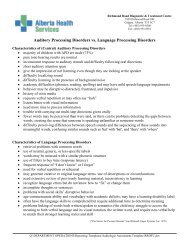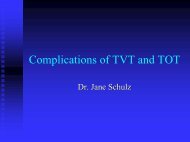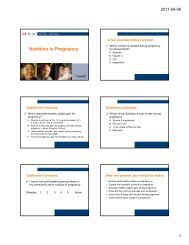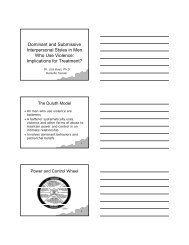Management of Preeclampsia - Onehealth.ca
Management of Preeclampsia - Onehealth.ca
Management of Preeclampsia - Onehealth.ca
You also want an ePaper? Increase the reach of your titles
YUMPU automatically turns print PDFs into web optimized ePapers that Google loves.
<strong>Management</strong> <strong>of</strong> Hypertensive<br />
Disorders <strong>of</strong> Pregnancy:<br />
What Is The Evidence, Really?<br />
Nao Nakatsuka PGY3<br />
January 4, 2010<br />
Perinatal Rounds
Duley et al. BMJ 2006;332:463-468.<br />
Sibai et al. Lancet 2005;365:785–799.<br />
Introduction<br />
• Prevalence <strong>of</strong> hypertensive disorders <strong>of</strong><br />
pregnancy (HDP) in pregnant Canadian women:<br />
– 1% - preexisting HTN<br />
– 5 - 6% - GHTN<br />
– 1 - 2% - preeclampsia (2-7% in primips)<br />
– 0.1-0.2%<br />
0.2% - HELLP<br />
• Preexisting HTN ↑s s risk <strong>of</strong> preeclampsia by 10-<br />
20%
Introduction<br />
• Maternal and perinatal outcomes depend on:<br />
– GA at disease onset<br />
– Severity <strong>of</strong> disease<br />
– Presence <strong>of</strong> pre-existing existing medi<strong>ca</strong>l disorders<br />
– Quality <strong>of</strong> management<br />
• 75% <strong>of</strong> <strong>ca</strong>ses are mild with onset near term or<br />
intrapartum outcome good<br />
Sibai et al. Lancet 2005;365:785–799.<br />
Duley et al. BMJ 2006;332:463-468.
Pathophysiology<br />
INFLAMMATORY<br />
(high resistance)<br />
PROCESS<br />
Irminger-Finger. Int J Biochem & Cell Biol 2008:40;1979–1983.
Couple-related:<br />
• Limited sperm exposure<br />
• Primipaternity<br />
• Male partner who has<br />
fathered preeclamptic<br />
pregnancy<br />
Risk Factors for HDP<br />
Sibai et al. Lancet 2005;365:785–799.<br />
Magee et al. SOGC Guidelines No. 206 March 2008.<br />
Maternal or pregnancy-related:<br />
related:<br />
• Previous preeclampsia<br />
• Multifetal gestation<br />
• Antiphospholipid Abs<br />
• Preexisting medi<strong>ca</strong>l condition(s)<br />
– HTN<br />
– Renal dz / proteinuria<br />
– DM<br />
• Extremes <strong>of</strong> maternal age<br />
• Obesity / excessive wt gain in pregnancy<br />
• Interpregnancy interval ≥ 10 yrs<br />
• Infections in pregnancy<br />
• Thrombophilia<br />
• Family hx <strong>of</strong> preeclampsia<br />
• Race (Black, South Asian, Pacific Island,<br />
Nordic)<br />
• NON-smoking!
Compli<strong>ca</strong>tions <strong>of</strong> HDP<br />
Maternal:<br />
• Placental abruption<br />
• HELLP / DIC<br />
• Pulmonary edema<br />
• Acute renal failure<br />
• Eclampsia<br />
• Liver failure or<br />
hemorrhage<br />
• Stroke (rare)<br />
• Death (rare)<br />
• Long-term <strong>ca</strong>rdiovascular<br />
morbidity<br />
Fetal/Neonatal:<br />
• Preterm delivery and associated<br />
compli<strong>ca</strong>tions<br />
• IUGR<br />
• Hypoxia-induced induced neurologic<br />
injury<br />
• Perinatal death<br />
• Long-term <strong>ca</strong>rdiovascular<br />
morbidity associated with low<br />
birth wt (fetal origin <strong>of</strong> adult dz<br />
hypothesis)<br />
Sibai et al. Lancet 2005; 365: 785–99.
Diagnosis and<br />
Classifi<strong>ca</strong>tion <strong>of</strong> HDP
Dx <strong>of</strong> GHTN:<br />
SOGC Guidelines (Mar 2008)<br />
• dBP ≥ 90 mmHg<br />
– Average <strong>of</strong> at least 2 measurements with same arm – 70%<br />
normalize<br />
– > 90 mmHg perinatal morbidity ↑<br />
– dBP better predictor <strong>of</strong> adverse pregnancy outcomes than sBP<br />
follow closely for ↑ dBP<br />
• sBP ≥ 140 mmHg follow closely for<br />
– Higher fluctuation not used for Dx<br />
• Isolated <strong>of</strong>fice (white coat) HTN = <strong>of</strong>fice DBP ≥ 90 mmHg but home<br />
BP < 135/85 mmHg<br />
• Note: Onset <strong>of</strong> GHTN < 34 wks 35% develop preeclampsia<br />
Magee et al. SOGC Guidelines No. 206 March 2008.
Dx <strong>of</strong> Severe GHTN:<br />
SOGC Guidelines (Mar 2008)<br />
• sBP ≥ 160 mmHg or dBP ≥ 110 mmHg<br />
• Tx thought to prevent cerebrovascular and <strong>ca</strong>rdiovascular<br />
compli<strong>ca</strong>tions<br />
• sBP cut-<strong>of</strong>f based on <strong>ca</strong>se series by Martin et al:<br />
– 28 pts with severe preeclampsia and eclampsia & strokes<br />
– Hemorrhagic stroke in 25 pts, thrombotic in 2 pts<br />
– Of 24 pts being treated immediately before stroke:<br />
• sBP ≥ 160 mmHg in 23 pts and ≥ 155 mmHg in all<br />
• But, dBP ≥ 110 mmHg in only 3 pts<br />
– Maternal mortality 53.6%; only 3 pts es<strong>ca</strong>ped permanent<br />
morbidity<br />
• Eclampsia is not necessarily related to severe HTN<br />
– UK PRECOG study (BMJ) - 34% <strong>of</strong> eclamptic women had max<br />
dBP ≤ 100 mmHg<br />
Martin et al. Obstetrics & Gynecology 2005;105:246-254.<br />
Frias Jr et al. Current Opinion in Obstetrics and Gynecology 2003, 15:489–495.<br />
Milne et al. BMJ 2005;330:576-80. Magee et al. SOGC Guidelines No. 206 March 2008.
Proteinuria:<br />
SOGC Guidelines (Mar 2008)<br />
• Urine dipstick may be used for screening when<br />
suspicion <strong>of</strong> preeclampsia low<br />
– +1 correlates with ~ 0.3g/24h<br />
– Strongly suspicious if ≥ 2+<br />
• 24h urine or spot urine Pr:Cr ratio encouraged<br />
when ↑ suspicion <strong>of</strong> preeclampsia (↑BP,(<br />
s/s <strong>of</strong><br />
preeclampsia)<br />
– Proteinuria = 0.3g/24h or 30 mg/mmol<br />
mmol<br />
in spot<br />
Magee et al. SOGC Guidelines No. 206 March 2008.
Urine Dipstick and Spot Urine Pr:Cr<br />
vs. 24 Hour Urine<br />
• How good is the dipstick at detecting proteinuria (gold<br />
std = 0.3g/24h urine)?<br />
– Waugh et al: analysis <strong>of</strong> 6 studies evaluating dipstick urinalysis:<br />
s:<br />
≥ 1 pooled + LR = 3.48, pooled – LR = 0.6<br />
• How good is the spot urine Pr:Cr at detecting proteinuria<br />
(gold std = 0.3g/24h urine)?<br />
– Cut <strong>of</strong>f <strong>of</strong> 30mg/mmol sens 85%, spec 76%<br />
Although spot urine is accepted as diagnostic test by<br />
some countries, Cdn guideline still recommends 24h<br />
urine as gold std<br />
Waugh et al. Obstet Gynecol 2004;103:769–77.<br />
Magee et al. SOGC Guidelines No. 206 March 2008.
Classifi<strong>ca</strong>tion <strong>of</strong> HDP<br />
Preexisting HTN<br />
(pre-pregnancy or<br />
< 20 wks GA)<br />
With preeclampsia<br />
(≥ 20wks GA)<br />
• Resistant HTN (requires 3 meds for<br />
control <strong>of</strong> BP)<br />
• New or worsening proteinuria<br />
• Adverse condition(s)<br />
With comorbid<br />
conditions<br />
• DM I or II<br />
• Renal disease<br />
• Any other condition for antihypertensive<br />
therapy outside pregnancy<br />
Magee et al. SOGC Guidelines No. 206 March 2008.
Classifi<strong>ca</strong>tion <strong>of</strong> HDP<br />
Gestational HTN<br />
(≥ 20 wks GA)<br />
With preeclampsia<br />
(≥ 20wks GA)<br />
• New proteinuria<br />
• Adverse condition(s)<br />
With comorbid<br />
conditions<br />
• DM I or II<br />
• Renal disease<br />
• Any other condition for antihypertensive<br />
therapy outside pregnancy<br />
Magee et al. SOGC Guidelines No. 206 March 2008.
Severe <strong>Preeclampsia</strong><br />
• Severe preeclampsia:<br />
– Onset < 34 wks or<br />
– Heavy proteinuria (> 3g/d) or<br />
– Adverse condition(s)<br />
• 10–20% with severe preeclampsia develop HELLP<br />
syndrome<br />
• Note: Data on correlation between magnitude <strong>of</strong><br />
proteinuria & maternal/perinatal prognosis not consistent<br />
heavy proteinuria retained in definition <strong>of</strong> severe<br />
preeclampsia until new evidence arises<br />
Magee et al. SOGC Guidelines No. 206 March 2008.<br />
Irminger-Finger. Int J Biochem & Cell Biol 2008:40;1979–1983.
Adverse Conditions:<br />
Maternal Manifestations<br />
• Persistent / new / unusual headache<br />
• Visual disturbance<br />
• Persistent abdominal / RUQ pain<br />
• Severe N/V<br />
• Chest pain, dyspnea<br />
• Jaundice (late sign <strong>of</strong> DIC)<br />
• Signs <strong>of</strong> end-organ dysfunction: eclampsia, pulmonary edema,<br />
placental abruption<br />
• Severe HTN<br />
• Abnormal labs<br />
– ↑ Cr [according to lo<strong>ca</strong>l lab criteria]<br />
– ↑ AST, ALT, LDH [according to lo<strong>ca</strong>l lab criteria]<br />
– Plt < 100x10^9/L<br />
– Albumin < 20g/L<br />
Magee et al. SOGC Guidelines No. 206 March 2008.
Adverse Conditions:<br />
Maternal Manifestations<br />
• NOT part <strong>of</strong> criteria:<br />
– Clonus / hyperreflexia, , edema / wt gain: non-specific,<br />
common in pregnancy<br />
– Oliguria: : non-specific, many <strong>ca</strong>uses (including ↑ ADH<br />
after stress or surgery, oxytocin)<br />
• Do NOT fluid-overload<br />
pulmonary edema is #1 <strong>ca</strong>use <strong>of</strong><br />
death with preeclampsia<br />
• Oliguria (< 15 mL/h) ) should be tolerated, at least over first<br />
6h postpartum, in women who do not have ↑ Cr or pre-<br />
existing renal dz<br />
– Uric acid:<br />
• Literature on uric acid as predictor <strong>of</strong><br />
maternal/perinatal compli<strong>ca</strong>tion <strong>of</strong> preeclampsia<br />
conflicting<br />
Magee et al. SOGC Guidelines No. 206 March 2008.<br />
Koopmans et al. European J Obst & Gyn and Repro Biol 2009:146;8–14.
Adverse Conditions:<br />
Fetal Manifestations<br />
• Oligohydramnios<br />
• IUGR (usually asymmetri<strong>ca</strong>l, but<br />
may be symmetri<strong>ca</strong>l if severe<br />
placental disease)<br />
• Abnormal Doppler velocimetry <strong>of</strong><br />
umbili<strong>ca</strong>l artery<br />
– S/D ratio, resistance index,<br />
pulsatility index<br />
– AEDF, REDF<br />
• ↓ resistance to flow in fetal MCA<br />
(brain sparing)<br />
• Abnormal ductus venosus<br />
waveform<br />
• Stillbirth<br />
Magee et al. SOGC Guidelines No. 206 March 2008.
Case: Mrs. FM
Mrs. FM<br />
• ID: 33yo G4P1 Filipino female at 28+1 weeks with<br />
preexisting HTN (dx(<br />
dx’ed<br />
at 15 weeks) and IGT<br />
• HPI:<br />
– Transferred from GNH Nov 26 due to severe HTN and<br />
preeclampsia<br />
• Sept 4 Pr:Cr = 11.39, Nov 18 urate = 380, Nov 22<br />
24h prot
Mrs. FM<br />
• O/E:<br />
– BP labile (108-168 168 / 80-110)<br />
– NST normal except minimal variability<br />
– No abdo tenderness, reflexes normal, no clonus<br />
• U/S Nov 26:<br />
– BPP 8/8, AFI 12.5, EFW 10-50%ile, UA doppler<br />
normal<br />
• Inpt surveillance:<br />
– VS q shift<br />
– NST daily<br />
– Labs 3x/week<br />
– BPP 2x/week
Mrs. FM<br />
• Episodes <strong>of</strong> severe HTN:<br />
– Acutely treated with Adalat PA 10mg BP down to<br />
108/80 plan changed to use IV labetalol instead<br />
– Labetalol ↑ed to 200mg tid; Adalat XL 20mg bid<br />
added later ↓ed to 20mg daily<br />
• NST – min variability but no decels<br />
• U/S Nov 28 - BPP 8/8, UA doppler ↑ resistive index (0.8)<br />
and S:D ratio (5.0 95%ile for GA), MCA doppler brain<br />
sparing<br />
• U/S Dec 3 – BPP reassuring, UA doppler AEDF, MCA<br />
doppler brain sparing, DV normal
Mrs. FM<br />
• Dec 7 (29 weeks):<br />
– BP – 171/116 to CR for cont EFM<br />
– NST – min variability, intermittent small decels x < 1<br />
min<br />
– U/S – BPP 8/8, intermittent REDF<br />
– Labs – Plt 149 (↓),(<br />
ALT 41 (↑)(<br />
– BP treated with labetalol 20mg iv x2 then 40mg iv x 1<br />
still > 160/110<br />
– After discussion among Ob/Gyn<br />
Gyn, , perinatal and Ob<br />
Med, decision made for urgent C/S 980g infant,<br />
6 1 8 5 , bag/mask resus only
Mrs. FM<br />
• Postpartum:<br />
– HTN intermittently severe (Dec 8 – Dec 12) <br />
• Adalat PA 10mg prn<br />
• Adalat XL 30mg bid, Labetalol 100mg bid<br />
– Plt 104 (Dec 8) 88 (Dec 10) 133 (Dec 12)<br />
– Hb 54 (Dec 8) CT showed bladder flap and ant<br />
abdominal hematoma 3U PRBC Hb 111<br />
– D/C’ed<br />
Dec 14<br />
• BP 120 – 140’s s / 80 – 90’s<br />
• Hb 115, Plt 167<br />
• Rx for Adalat XL 30mg bid, Labetalol 100mg bid
<strong>Management</strong> <strong>of</strong> HDP
Bedrest:<br />
Does It Improve Outcomes?<br />
• For preeclampsia – 2 RCTs, , N=145:<br />
– Strict (vs. some) bedrest NO improvement in<br />
maternal/perinatal outcomes<br />
not recommended<br />
• For GHTN (no preeclampsia) – 1 RCT, N=218:<br />
– In-pt management with AAT in ward (vs. out-pt<br />
routine activity) ↓ severe HTN (RR 0.58; 95% CI<br />
0.38–0.89) 0.89) and PTB (RR 0.53; 95% CI 0.29–0.99),<br />
but NO improvement in perinatal outcomes<br />
• No RCTs on bedrest vs AAT<br />
• Conclusion: No evidence that bedrest improves<br />
outcomes, and may ↑ VTE risk consider allowing<br />
ambulation<br />
Meher et al. Cochrane Database <strong>of</strong> Systematic Reviews. 2007. CD003514.
Maternal and Fetal Surveillance –<br />
How Often?<br />
• No large prospective studies validating<br />
frequency <strong>of</strong> monitoring<br />
• Mild GHTN: out-pt<br />
– Maternal:<br />
• Self-assessment <strong>of</strong> adverse symptoms daily<br />
• BP and urine dipstick 2x/wk<br />
• Hb, Plt, , Cr, ALT/AST weekly<br />
– Note: coag function tests NOT needed if plt and liver enzymes<br />
normal<br />
– Fetal:<br />
• NST, U/S for EFW and AFI if normal, no need for repeat<br />
testing unless maternal condition changes<br />
Sibai. Obstetrics and gynecology. 2003:102(1):181-192.
Maternal and Fetal Surveillance<br />
• Mild preeclampsia: out-pt<br />
– Maternal:<br />
• Self-assessment <strong>of</strong> adverse symptoms daily<br />
• BP and urine dipstick daily<br />
• Hb, Plt, , Cr, ALT/AST, 24h urine protein weekly<br />
– Fetal:<br />
• Kick count daily<br />
• NST (or BPP) weekly 2x/wk if oligo/IUGR<br />
• U/S for growth and AFI q 3 weeks<br />
• Note: Mild GHTN/preeclampsia may be managed<br />
as out-pt only if compliant, logisti<strong>ca</strong>lly feasible,<br />
and not progressing into severe disease<br />
Sibai. Obstetrics and gynecology. 2003:102(1):181-192.<br />
ACOG Practice Bulletin #33 Jan 2002.
Maternal and Fetal Surveillance<br />
• Severe <strong>Preeclampsia</strong>: in-pt at tertiary<br />
centre<br />
– Maternal:<br />
• BP, urine output, symptoms/signs <strong>of</strong> end-organ<br />
dysfn<br />
• Labs daily or more frequent<br />
– Fetal:<br />
• Cont EFM intermittent NSTs<br />
• U/S for BPP, AFI, EFW, Doppler<br />
Sibai. Obstetrics and gynecology. 2003:102(1):181-192.
Severe HTN<br />
sBP ≥ 160 or dBP ≥ 110<br />
• Confirm in 15 min then treat<br />
Drug<br />
Labetalol<br />
Nifedipine<br />
Hydralazine<br />
Dose<br />
•2020 mg iv rpt 20-80 mg q 30 min or<br />
•1-22 mg/min iv<br />
•Max Max 300 mg (then switch to po)<br />
•5-1010 mg <strong>ca</strong>psule bitten/swallowed q 30 min or<br />
•1010 mg PA q 45 min<br />
•Max Max 80 mg/d<br />
•55 mg iv rpt 5-105<br />
mg iv q 30 min or<br />
•0.5-10 mg/h iv<br />
•Max Max 20 mg<br />
Magee et al. SOGC Guidelines No. 206 March 2008.
Non-Severe HTN<br />
sBP 140–159 159 or dBP 90–109<br />
• Targets:<br />
– No comorbid conditions: 130–155 155 / 80–105<br />
– + comorbid conditions: 130–139 139 / 80–89<br />
89<br />
– Avoid low BP placental hypoperfusion<br />
• Debate over tx <strong>of</strong> non-severe HTN<br />
– Systematic review 2006: 28 RCTs, , N=3200<br />
• Use <strong>of</strong> drug(s) ) halved severe HTN (RR 0.50, 95% CI 0.41- 0.61)<br />
• No diff in pre-eclampsia<br />
eclampsia, , perinatal death, preterm birth, SGA<br />
– Meta-analysis analysis 2000: 45 RCTs, , N=3773<br />
• ↓ in MAP correlated to SGA and lower birth wt<br />
Placental hypoperfusion?<br />
Magee et al. SOGC Guidelines No. 206 March 2008.<br />
Abalos et al. Cochrane Database <strong>of</strong> Systematic Reviews 2006. CD002252.<br />
Von Dadelszen et al. Lancet 2000;355:87-92.
Drug<br />
Non-Severe HTN<br />
sBP 140–159 159 or dBP 90–109<br />
Dose<br />
Labetalol • 100-400mg bid-tid<br />
(max 1200mg/d)<br />
Methyldopa • 250-500mg 500mg bid-qid<br />
(max 2g/d)<br />
Nifedipine •PA: PA: 10-20mg 20mg bid-tid<br />
(max 180mg/d)<br />
•XL: XL: 20-60mg 60mg daily (max 120mg/d)<br />
Magee et al. SOGC Guidelines No. 206 March 2008.
Notes on Antihypertensive Drugs<br />
• Labetalol and methyldopa used most frequently in<br />
Canada<br />
– Labetalol may be slightly more effi<strong>ca</strong>cious (10 trials, N=539; RR<br />
0.75, 95% CI 0.58–0.94)<br />
0.94)<br />
• No evidence <strong>of</strong> adverse pediatric long-term health or<br />
neurodevelopmental outcomes<br />
• ACEI contraindi<strong>ca</strong>ted in any trimester<br />
– T2/3: linked to IUGR, oligohydramnios, renal dysplasia<br />
– T1 (Cohort(<br />
study 2006, N=29,507): linked to malformation <strong>of</strong><br />
CVS (RR 3.72) and CNS (RR 4.39)<br />
– If pt was on ACEI/ARB pre-conception for renoprotection, , restart<br />
postpartum (compatible with breastfeeding)<br />
Magee et al. SOGC Guidelines No. 206 March 2008.<br />
Cooper et al. NEJM 2006;354:2443-51.
Magnesium Sulfate and Eclampsia<br />
• Tx <strong>of</strong> eclampsia:<br />
– MgSO4 more effectively reduces recurrent seizures than<br />
phenytoin (6 trials, N=897) or diazepam (7 trials, N=1441)<br />
• Prevention <strong>of</strong> eclampsia:<br />
– MAGPIE: Multicentre RCT, N=10,141<br />
– Antepartum or ≤ 24h postpartum, BP ≥ 140/90, proteinuria ≥ 1+,<br />
clini<strong>ca</strong>l uncertainty about using MgSO4<br />
– IV: MgSO4 4g over 10-15min 15min then 1g/h x 24h<br />
– IM: MgSO4 5g in each buttock then 5g q4h x 24h<br />
– Recurrent sz: : 2g iv bolus over 5-10min5<br />
– MgSO4 reduced risk <strong>of</strong> eclampsia by 58% (95% CI 0.40–0.71),<br />
0.71),<br />
NNT=91<br />
Duley et al. Lancet 2002;359:1877-90.
To Deliver or<br />
Not To Deliver?
Mode <strong>of</strong> Delivery<br />
• Consider IOL first; C/S only for usual obstetri<strong>ca</strong>l<br />
indi<strong>ca</strong>tions<br />
• IOL with severe preeclampsia takes more time<br />
and less successful than with normal BP<br />
– Success 60% at > 32 wks, 10% at < 26 wks<br />
– IUGR or oligohydramnios not contraindi<strong>ca</strong>tions - may<br />
consider oxytocin challenge test<br />
– Doppler findings:<br />
• ↑ resistance to diastolic flow vaginal delivery rate > 50%<br />
• AEDF or REDF most babies delivered by C/S<br />
• If thrombocytopenic or DIC, ↑ risk <strong>of</strong> PPH<br />
– Do NOT use ergometrine! ! (↑(<br />
risk <strong>of</strong> stroke)<br />
Magee et al. SOGC Guidelines No. 206 March 2008.
<strong>Management</strong> ≥ 36 Weeks<br />
• SOGC Guidelines: <strong>Preeclampsia</strong> (severe or non-<br />
severe) consider delivery<br />
• HAPITAT study – multicentre RCT, N=383:<br />
– Population: 36-41 weeks, non-severe GHTN or<br />
preeclampsia<br />
– IOL vs expectant<br />
– 1° outcome: composite <strong>of</strong> poor maternal outcomes<br />
• Death, eclampsia, HELLP, pulmonary edema, VTE,<br />
placental abruption, progression to severe HTN or<br />
proteinuria, major PPH<br />
Magee et al. SOGC Guidelines No. 206 March 2008.<br />
Koopmans et al. Lancet 2009;374:979-88.
<strong>Management</strong> ≥ 36 Weeks<br />
• HAPITAT study<br />
– Results:<br />
• Poor maternal outcome in 31% <strong>of</strong> IOL<br />
group vs 44% <strong>of</strong> expectant group (RR 0.71,<br />
95% CI 0.59-0.86, 0.86, p
<strong>Management</strong> 34 - 35 Weeks<br />
• Non-severe preeclampsia insufficient<br />
evidence to recommend delivery vs<br />
expectant<br />
• In addition to neonatal concerns, ↑ data that<br />
late preterm birth is associated with delayed<br />
a<strong>ca</strong>demic performance<br />
• Severe preeclampsia delivery<br />
Magee et al. SOGC Guidelines No. 206 March 2008.<br />
Von Dadelszen et al. Semin Perinatol 2009:33;152-157.
<strong>Management</strong> 28 - 34 Weeks<br />
• Non-severe preeclampsia expectant<br />
• Severe preeclampsia deliver or expectant??<br />
• Cochrane Systematic Review:<br />
– 2 RCTs (Sibai/Mercer 1994, Odenhaal 1990), N=133<br />
with severe preeclampsia, GA 28-34 weeks<br />
– On admission:<br />
• Betamethasone<br />
• MgSO4 x 24 h<br />
• BP ≥ 160/110 treated<br />
Churchill et al. Cochrane Database <strong>of</strong> Systematic Reviews 2002 CD003106.
<strong>Management</strong> 28 - 34 Weeks<br />
• Cochrane Systematic Review:<br />
– Intervention group: C/S or IOL<br />
– Expectant group: bedrest, , maternal and fetal<br />
monitoring<br />
• Indi<strong>ca</strong>tions for delivery:<br />
1) Reached 34 weeks<br />
2) Maternal deteriorations (oliguria(<br />
oliguria,<br />
thrombocytopenia, ↑ ALT/AST, , imminent<br />
eclampsia, , severe HTN resistant to drugs)<br />
3) Fetal distress<br />
Churchill et al. Cochrane Database <strong>of</strong> Systematic Reviews 2002 CD003106.
<strong>Management</strong> 28 - 34 Weeks<br />
– Results:<br />
• Mean prolongation <strong>of</strong> pregnancy in expectant group = 7-14d7<br />
• Maternal: no diff in eclampsia, , renal failure, pulm edema,<br />
HELLP, C/S, abruption<br />
• Fetal/Neonatal:<br />
– No diff in death rate<br />
– Expectant group - ↓ RDS, NEC, NICU adm; ↑ SGA<br />
– Conclusion: Expectant management improves perinatal outcome<br />
without compromising maternal outcome recommended<br />
**As long as close monitoring possible!<br />
– Caveat: N was not large enough to study rare mat conditions<br />
(eg)) NO incidence <strong>of</strong> eclampsia or pulmonary edema)!<br />
Churchill et al. Cochrane Database <strong>of</strong> Systematic Reviews 2002 CD003106.
<strong>Management</strong> 24 - 28 Weeks<br />
• No RCT<br />
• Sibai, , retrospective review, N=84, 24-27+6 27+6 weeks,<br />
severe preeclampsia:<br />
– N=30 immediate delivery 48h after steroids<br />
– N=54 expectant management<br />
• Bed rest, steroids, antihypertensive tx for DBP ><br />
100, MgSO4 x 24-72h, 72h, close surveillance<br />
• Pregnancy continued until onset <strong>of</strong> maternal/fetal<br />
compli<strong>ca</strong>tions<br />
Sibai et al. Am J Obstet Gynecol. 1990;163(3):733-8.
<strong>Management</strong> 24 - 28 Weeks<br />
• Retrospective review:<br />
– Results <strong>of</strong> expectant management (vs(<br />
delivery):<br />
• Mean prolongation 13.2d (range 2-26d) 2 26d)<br />
• Sig. ↑ perinatal survival (76.4% vs 35%)<br />
• Sig. ↑ birth wt (880g vs 709g)<br />
• Sig. ↓ neonatal compli<strong>ca</strong>tions<br />
• No diff in maternal compli<strong>ca</strong>tions<br />
– Conclusion: Expectant management improves<br />
perinatal outcome without compromising maternal<br />
outcome recommended<br />
**As long as close monitoring possible!<br />
Sibai et al. Am J Obstet Gynecol. 1990;163(3):733-8.
<strong>Management</strong> < 24 Weeks:<br />
Retrospective Studies on Expectant <strong>Management</strong><br />
Pattinson et al<br />
(1988)<br />
Gaugler-Senden<br />
et al (2006)<br />
Budden et al<br />
(2006)<br />
Bombrys et al<br />
(2008)<br />
N 45 26 31 46 (51 fetuses)<br />
GA (wks)
<strong>Management</strong> < 24 Weeks<br />
• Conclusion: Expectant management
<strong>Management</strong> <strong>of</strong> HELLP<br />
• Haddad et al – no stat diff in adverse maternal<br />
or neonatal outcomes <strong>of</strong> HELLP vs severe<br />
preeclampsia ≤ 28 weeks (N=64)<br />
• Delivery concerns:<br />
– IOL in nullips
<strong>Management</strong> <strong>of</strong> HELLP<br />
• SOGC Guidelines:<br />
– Consider transfusing plts when plt < 50x10^9/L, plts<br />
falling rapidly, and/or coagulopathy<br />
– Strongly consider transfusing plts when plt <<br />
20x10^9/L for C/S and vaginal delivery<br />
– Plts may contain RBCs (4U plts <strong>ca</strong>n contain up to 2ml<br />
RBCs) give WinRho 300mcg if Rh -ve<br />
– Consider steroids when plt < 50x10^9/L<br />
• Systematic review:<br />
– Improvement in BP, urine output, lab values (plts(<br />
and<br />
liver enzymes), BUT<br />
– No diff in mat/perinatal outcomes<br />
Magee et al. SOGC Guidelines No. 206 March 2008.<br />
Matchaba et al. Cochrane Database <strong>of</strong> Systematic Reviews. 2003. CD002076.
Postpartum Treatment<br />
• ~50% with HDP have PP HTN<br />
• BP <strong>of</strong>ten peaks at PP day 3-63<br />
6 due to fluid shifts<br />
• Proteinuria and adverse conditions may worsen for few<br />
days PP<br />
• Tx <strong>of</strong> PP HTN:<br />
– ≥ 160/110 – treat in same manner as with antepartum<br />
– Non-severe with comorbidities: treat (as per Cdn HTN<br />
guidelines)<br />
– Non-severe without comorbidities: insufficient data<br />
• Consider thromboprophylaxis in women with<br />
preeclampsia, esp. post C/S or antenatal bedrest > 4 days<br />
(unproven benefit)<br />
Magee et al. SOGC Guidelines No. 206 March 2008.
Postpartum Resolution <strong>of</strong><br />
GHTN and Proteinuria – How Long<br />
Does It Take?<br />
• Berks et al - prospective cohort study, N=205 with preeclampsia<br />
– F/U at 1.5, 3, 6, 12, 18, and 24 mo PP<br />
– Results:<br />
• HTN: 39% + at 3 mo PP 18% + at 2 yrs PP<br />
– Resolution time ↑ with higher max BP and with longer<br />
dx-to<br />
to-delivery interval<br />
• Proteinuria:14% + at 3 mo PP 2% + at 2 yrs PP<br />
– Resolution time ↑ with higher max proteinuria<br />
• GA at onset <strong>of</strong> preeclampsia not correlated with resolution<br />
time <strong>of</strong> HTN and proteinuria<br />
– Conclusion: Up to 2 yrs for HTN and proteinuria to resolve <br />
may postpone further invasive work-up for underlying renal<br />
disease until 2 yrs PP<br />
Berks et al. Obstetrics and gynecology Dec 2009;114(6):1307-14.
Take-Home Points<br />
• Classifi<strong>ca</strong>tion:<br />
Gestational/preexisting HTN<br />
± <strong>Preeclampsia</strong><br />
± Comorbid conditions<br />
• 24h urine for proteins still gold standard<br />
• No evidence for bedrest<br />
• No RCTs on frequency <strong>of</strong> maternal/fetal<br />
surveillance<br />
• Debate over whether or not to treat non-severe<br />
GHTN
Take-Home Points<br />
• <strong>Management</strong>:<br />
– ≥ 36 weeks: deliver<br />
– 34 – 35 weeks:<br />
• Severe preeclampsia deliver<br />
• Non-severe preeclampsia insufficient data<br />
– 24 - 34 weeks: expectant<br />
– < 24 weeks: <strong>of</strong>fer termination <strong>of</strong> pregnancy
Take-Home Points<br />
• Postpartum:<br />
– Treat severe HTN and non-severe HTN<br />
with comorbidities<br />
– Insufficient data on tx <strong>of</strong> non-severe<br />
HTN w/o comorbidities<br />
– GHTN and proteinuria do not resolve in<br />
many women for prolonged period <strong>of</strong><br />
time<br />
– Follow-up important
THANK YOU!!<br />
Special Thanks to Dr. Venu Jain
















